Amandria Brunner headed to trial
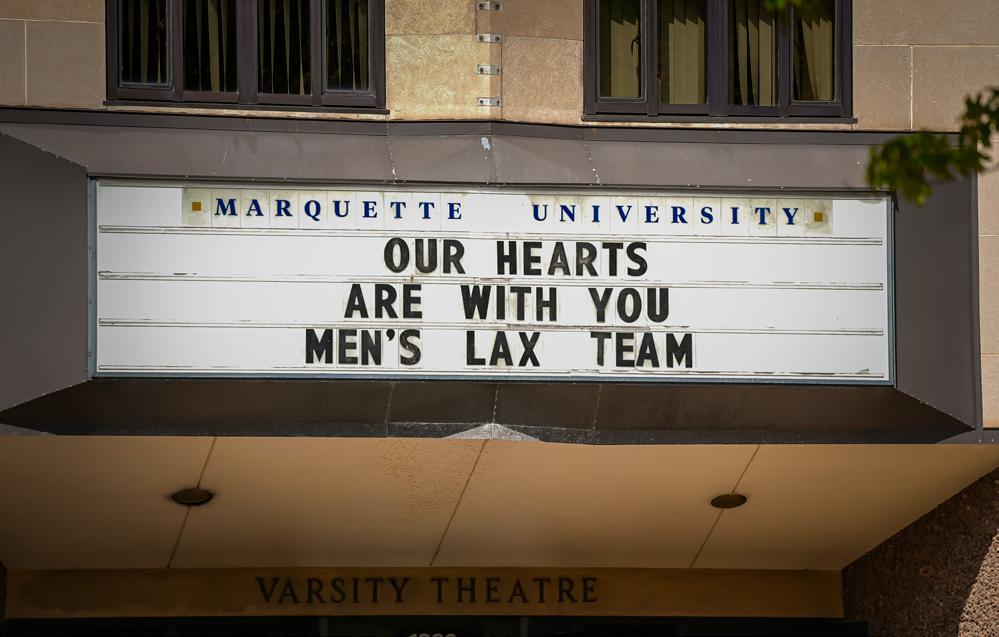
By Jack Albright & Sophia Tiedge jack.albright@marquette.edu sophia.tiedge@marquette.edu
Amandria Brunner, the woman charged in the Sept. 5 deaths of Marquette men’s lacrosse players Scott Michaud and Noah Snyder, will go to trial on four counts of homicide — two for driving with a prohibited alcohol concentration and two for intoxicated use of a vehicle.
Brunner appeared in court Oct. 2 for her preliminary hearing, at which Milwaukee Circuit Court Judge David Borowski rejected a request by defense attorney Abigail Ruckdashel to dismiss the case, after finding there was probable cause to establish that a felony had

been committed.
Brunner was originally charged with two counts of homicide by intoxicated use of a vehicle; the prosecution added the two extra charges at the Oct. 2 hearing. Each individual charge holds a maximum prison sentence of up to 40 years.
Ruckdashel entered Brunner’s not guilty plea, and requested a substitution in judge, which Borowski accepted. Brunner’s next court appearance will be Oct. 16 with Milwaukee Circuit Court Judge David Swanson presiding.
When she entered the courtroom, Brunner was emotionally distraught, weeping on and off, visibly shaking and rocking back and forth with
her head down during the proceedings.
Marquette men’s lacrosse head coach Jake Richard and defensive coordinator Will Roberts were present. Individuals for the victims and Brunner also attended.
Brunner had one prior OWI charge from the City of Greenfield in 2003.
Milwaukee police officer William Hanney, of the crash reconstruction unit, testified during the hearing.
Hanney said there was a can of Miller High Life behind the front seat, which “clearly had been opened before the crash because the pull tab was open.”
Additionally, Hanney said officers found suspected marijuana on Brunner; after further
testing, this was confirmed. He said other “drug paraphernalia” was found on her when arrested.
Upon inspection of the airbag control module on Brunner’s white Ford Ranger, Hanney found she “accelerated rapidly” without braking when turning left into the intersection of North 27th Street and West St. Paul Avenue. The criminal complaint said Brunner had the accelerator depressed 96% and was traveling at 11.8 mph — in a 30 mph zone — at the time of the crash.
Hanney said inspection of the airbag control module of the silver Jeep carrying Snyder and Michaud showed the car traveling at an average speed of around 53 mph. Hanney
said the driver of the Jeep briefly touched the brakes before pushing the gas pedal at “100% throttle for two seconds before the crash occurred.”
Ruckdashel, Brunner’s attorney, as well as Dustan Davidson, who is working with Ruckdashel on the case, graduated from Marquette Law School in 2024. Borowski, the original judge assigned to the case, also graduated from Marquette Law School.
There is currently a $75,000 cash bail for Brunner’s release. She has a no contact order with the families of both victims and the four other students who were in the car during the crash.
The state’s investigation into the crash is ongoing.
Tuesday, OcTOber 7, 2025
Church of Gesu to open earlier than expected
Construction will be completed by Nov. 30, 2025
By Elena Metindis elena.metindis@marquette.edu
The Church of the Gesu is reopening its doors on Nov. 30 after being closed for one year due to renovations.
The upgrades, budgeted for $10.1 million, are revamping the upper-level church while also preserving its historical beauty.
“It’s going to be a magnificent space,” Rev. Michael Simone, S.J., pastor of Gesu Parish, said.
The plan includes new flooring and pews, repainting of the walls and the
community for over a century. The church is a focal point of Marquette’s campus, and its parish members work closely with Campus Ministry, although it is affiliated with the Archdiocese of Milwaukee.
“Gesu is really an amazing gathering space for the Marquette community,”
Lynn Griffith, Marquette’s chief marketing and communication officer, told the Marquette Wire. “When you look up at Gesu, you know that there’s a presence bigger than you.”
Since December 2024, daily and Sunday Masses have been held in the lower-level church, which holds 450 people in comparison to the 1,100-person capacity of the

upper church.
ceiling, improved light and sound systems, a new baptismal font and the relocation of the tabernacle. An updated fire alarm system and security cameras will also be installed.
Gesu has served Marquette community for decades
Built in 1893, Gesu has been serving the Milwaukee and Marquette
With renovations on schedule, parishioners can look forward to the upper church doors opening in just under eight weeks. Renovation images and updates have consistently been posted on Gesu’s website as construction has developed since last December.
Simone is hoping to hold the first Mass in the renovated church on the first

Sunday of Advent — one day earlier than the anticipated Dec. 1 opening.
“Our contractor is so confident that he’s already scheduled the city inspector to come in November and give the occupancy license,” Simone said.
Parishioners looking forward to seeing the remodeled church can take a sneak peek via the video fly-through simulation and browse through the renovation descriptions.
Project goal is to preserve church’s historical aesthetic
Though much of Gesu will be brand new once renovations are finished, the parish’s goal is to preserve the historical accuracy and aesthetics of the upper level.
“We are a historical property. In two important ways, we’re going back to an earlier reality of the church,” Simone said.
The current pews, which Simone said were giving parishioners splinters and didn’t match the era of Gesu, are being replaced with pews that resemble the original 20th-century design. The pews will be placed in the same formation and will be made of oak wood to match the existing doors and balcony.
The tabernacle, which was moved to the right side of the altar in the 1960s, will be relocated to the center under the crucifix. The tabernacle is the dwelling place of the Eucharist (consecrated bread and wine) and is locked away safely outside of Mass times. Simone said this change acknowledges that the Blessed Sacrament, or Eucharist, is “the living presence” in the church.
Additionally, new artwork on the ceiling will reflect the historical nature of Gesu and resemble other churches from the same time period.
“We’re being really sensitive to the artistry that was here in the 1890s-1920s, but also making it appropriate for the 21st century,” Simone said.
Walking past Gesu every day is a reminder that Marquette is a Jesuit Catholic university, Conner Pecard, a sophomore in the School of Education, said. He is thankful to have Gesu as a stunning gathering space in the community.
“Churches are meant to be created beautiful because they point towards how beautiful God is,” Pecard said. “The ability to worship in such a nice space is a huge gift for our community.”
Other upgrades included in the renovation are as follows:
- Durable porcelain flooring to replace 40-year-old tiles that did not wear well, also allowing for the addi-

tion of ramps to the altar for greater accessibility.
- Mobility and functionality improvements in the layout for inclusivity.
- An updated sound system that will replace the current sound system prone to failure.
- Energy-efficient hanging pendant light fixtures with dimming options.
- A baptismal font in the main entrance and an ambry for holy oils near it.
- The option for hearing aids with T-coils to connect directly to the church sound system.
- A new fire detection system that covers more space and connects to the Marquette University
sure safety.
While Gesu already holds daily and Sunday Mass, leaving the church doors open throughout the day is a new effort that aims to create a peaceful place for all people to enjoy at their convenience.
Pecard, among other students, is grateful to have access to Gesu.
“It’s my heavenly home on campus. I feel like I know it as well as my dorm room,” he said.
Simone and other members of the community are hoping the renovations will be an initial element that draws people to Gesu, a “calling card” that will invite community mem-

Police Department.
- Security cameras monitored by MUPD. Renovations will allow for greater citywide openness
Another effort set to roll out is that the church will be left open during the day, providing a quiet place in the city for prayer, Simone said. When Gesu reopens, a welcome desk will ensure that someone is always in the church, and MUPD is committed to helping en-
bers to be curious about the church.
After just under one year of construction, community members are confident Gesu’s new features will help the parish continue to be a heartbeat on Marquette’s campus and thrive for years to come.
“Gesu is so special to so many people, and this renovation will make it even more beautiful and iconic,” Griffith said.
Trump's approval rating continues to decline
A new MU Law Poll asked voters about U.S. issues
By Mia Thurow mia.thurow@marquette.edu
President Donald Trump’s overall job performance in September was 43%, with 57% disapproval, according to a Marquette Law School national survey released Oct. 1. Between Sept. 15 and 24, 1,043 adults were interviewed.
The margin of error was 3.3 percentage points.
Trump’s approval rating has continually declined in small increments since he was sworn into office.
In January 2025, 48% approved of the president and 52% disapproved. According to the law poll survey, approval of Trump varies across issues; the highest rating being 55% approval of his handling of border security and 53% approval of his response to the assassination of conservative activist Charlie Kirk.
The president’s lowest approval rating was 28%
for handling information about Jeffrey Epstein, the late American financier and child sex offender. Approval of Trump’s dealing with inflation and the cost living is slightly higher, at 29%.
Trump’s job performance received net negative approval ratings on every issue except for border security and his response to the assassination of Kirk.
According to the survey, Americans disapprove of how Trump handles immigration, the economy, global wars, tariffs and a number of other issues. His net approval ranged from +10 percentage points to -44 percentage points.
Variation among Republicans and Independents can lead to a variety of approval across issues. Among all adults surveyed, approval ranged from 28% to 55%, but among Republicans the range was from 46% to 89%. Independents and Democrats varied less than Republicans; ranging from 14% to 46% approval for the former and 5% to

23% for the latter.
Overall Republican approval, 81%, remains strong for Trump, though that number is eight percentage points lower than it was in January. Democrats’ approval declined
one point since January, to 8%.
The results of the survey come amidst a partial shutdown of the government after Congress failed to reach an agreement on the federal spending plan. It’s the first since the longest shutdown in U.S. history in 2018, which took place for 35 days while Trump was in office due to objections over funding the border wall.
What additional yearly fees do students pay?
The charges include UPASS, health services
By Sahil Gupta sahil.gupta@marquette.edu
In addition to tuition and housing costs, Marquette University students pay $1,200 in annual fees to different entities around campus. Over four years, this amounts to $4,800 in fees.
Some students are aware of the additional fees they are charged; however, some feel there is a lack of transparency about what the fees go toward. Andrew Romaszewski, a first-year student in the College of Engineering, talked about the challenges of uncovering those details.
“I know what the label says on the website. However, I think that label is very unclear about what specifically
it goes towards,” Romanszewski said. “In order to find it out, you have to go through Marquette’s website, which is rather cumbersome.”
Deanna Davis, manager of Marquette Central, provided the Marquette Wire with information about all the mandatory fees that students are assessed each semester. Here’s what students should know about the fees they pay: Technology fee
The $150 student technology fee helps the university cover expenses relating to information technology needs, such as internet and computer services.
“The technology fee contributes to the purchase of implementation, staffing and support of information technology that directly benefits students and the academic learning environment,” Davis said in an email.

Raynor Library houses several technology resources for students to use, including desktop computers and charging stations for personal devices. It also has a handful of MacBooks and Windows laptops for students to temporarily check out. Lena Schultz, a firstyear student in the School of Education, has been borrowing a MacBook daily since late September.
“I’m renting a computer every day because my computer is currently broken,” Schultz said. “It’s nice that it’s free and I can use it.”
Student health services fee
The $210 student health services fee helps support organizations such as the Counseling Center and Medical Clinic.
“The health fee covers unlimited office visits, some laboratory studies and reduced prices on additional services,” Davis said.
Marquette’s medical fee is less compared to other Jesuit universities, some of which require students to pay for a university health insurance plan.
Georgetown University charges students $4,350 per year for health insurance. Creighton University does not immediately require students to enroll in a health insurance plan; however, they do offer a plan that costs $1,992 for six months.
Students who attend these schools are able to apply for waivers if they have private insurance through their
employer or their parents. Marquette does not require students to be on a university health insurance plan, however, the Medical Clinic is not able to bill students’ individual insurance companies. The clinic instead encourages students to submit any bills from the Marquette Medical Clinic to their insurance companies to request reimbursements when they need to pay extra for services received on campus.
Student activity fee
Students are charged a $40 activity fee each semester. All funds collected in this category go into the Student Organization Fund run by Marquette University Student Government. Organizations are then able to request funding for events and endeavors through MUSG.
MUSG has been hosting training sessions for clubs and organizations to learn about the SOF and how to make use of the available funding. Student government leaders are hoping that increased awareness of the fund will allow organizations to put on larger events that benefit the student body.
Wellness and recreation fee
The wellness and recreation fee is $150 per semester and goes toward maintaining the various recreational spaces on Marquette’s campus, including the new Wellness + Helfaer Recreation facility.
This semesterly fee costs
less than memberships at other local full-service athletic facilities. A membership for one adult through the Wisconsin Athletic Club costs $72 a month. That totals around $360 per semester, more than double the cost of Marquette’s recreation fee. Schultz, who is a member of the Marquette track and field team, is a frequent user of the recreation spaces on campus.
“I’m in the Rec Center pretty often. It’s mandatory for me,” Schultz said. UPASS fee
The semesterly $50 UPASS fee provides students with the ability to use the Milwaukee County Transit System’s 42 bus routes. The normal MCTS fare is $2 per ride with fare caps at $20 weekly or $75 monthly, making public transportation cheaper for Marquette students.
While some students expressed frustration with being required to pay for certain services, they did highlight the benefits the services can provide.
“I have never used the UPASS. I have my car here,” Schultz said. “However, I’m sure the UPASS is beneficial to people who need to get around.”
Students who have questions about fees or other financial concerns can contact Marquette Central, located in Zilber Hall Room 121. Students can also reach out by phone at (414) 288-4000.
Tuesday, OcTOber 7, 2025
The MarqueTTe Tribune
Managing Editor of The Marquette Tribune
Sophia Tiedge
NEWS Executive News Editor Mia Thurow
Assistant Editors Lance Schulteis, Lilly Peacock
Reporters Sahil Gupta, Elena Metinidis, Maeve Heeney, Mina Marsolek-Bonnet, Jaylen Hill, Daria Stepanich
ARTS & ENTERTAINMENT
Executive Arts & Entertainment Editor MaryKate Stepchuk
Reporters Elise Emery, Joseph Schamber, Allison Scherquist
OPINIONS
Executive Opinions Editor Rachel Lopera
Columnists Isabella Gruber
SPORTS Executive Sports Editor Jack Albright
Assistant Editors Matthew Baltz, Raquel Ruiz
Reporters Benjamin Hanson, Mikey Severson, Sofie Hanrahan, Ben Ward, Eamon Bevan, Conor McPherson
COPY
Copy Chief Emma Fishback
Copy Editors Elizabeth Belmont, Shea Lancaster, Marin Rooney
VISUAL CONTENT
Design Chief Murphy Lealos
A&E
Designer Grace Schneider
Sports Designer Amery Thompson
Opinions Designer Evelyn Riordan
Photo Chief Clay Ellis-Escobar
Photographer Lily Wooten, Owen Weis
HAVE A TIP FOR US?
Have you seen something that you think should be a story? Do you have a tip about something we should be looking into? Do you have documents or other materials that we should see? We want to hear from you. If you have documents you'd like to send us, you can send anything to wiretips@marquette.edu.

The results come from a Wall Street Journal survey
By Mia Thurow mia.thurow@marquette.edu
Marquette University again earned the title of best university in the Badger State, according to the 2026 Wall Street Journal/College Pulse Best Colleges in the U.S. rankings. Coming in at 82nd place nationally, Marquette beat out other institutions like the Universities of Wisconsin-Madison and Whitewater.
In the 2025 and 2024 rankings, Marquette was also deemed best university in Wisconsin. In 2025, it was ranked 55th nationally and 56th the year before.
Despite falling 27 places from its 2025 ranking, Marquette scored highly when it came to best salaries for graduates and finished among the top 75 institutions in the country.
The WSJ/College Pulse ranks the top 584 undergraduate institutions in the U.S. based on overall value provided to students. The
Funding for McNair Program cut
Marquette plans to appeal the federal decision
By Lance Schulteis lance.schulteis@marquette.edu
Marquette’s McNair Scholars Program will no longer be accepting students.
The program supporting low-income and first-generation students was discontinued by the Department of Education at the end of September following funding cuts to all Federal TRIO Programs.
The university announced the closure Sept. 22, though it plans to appeal the decision.
Marquette’s Educational Opportunity Program — which enables low-income and first-generation students to enter higher education — was awarded a $324,000 annual grant in 2022 to fund the McNair Scholars Program from October 2022 through September 2027. Funding was discontinued September 2025.
The money was part of a $51 million grant that funded stipends for graduate school preparation at Marquette and 188 other McNair chapters across the country.
Students in the McNair Program attend monthly seminars and conferences,
intern at the McNair Summer Research Institute and work with a mentor.
“With my mentor, I was able to learn more about my major and I was able to learn more about different opportunities that were offered in the school,” Ashley Sanchez Tiscareno, a junior in the College of Business Administration and former McNair Scholar, said.
The Marquette Wire reached out to recent McNair Scholars and program staff, but they either declined the interview or didn’t respond.
With the help of mentors and McNair faculty, students work on research papers for their applications to graduate school. Past research topics have included immigration, labor unions and foster care systems.
The budget cuts don’t impact the scholarship funds of current McNair Scholars.
At the national level, McNair Scholars is one of eight Federal TRIO programs, which combine to serve roughly 870,000 students each year.
Over six million students have graduated with the support of TRIO programs. McNair Scholars nationwide are 78% more likely to enroll in graduate school than other students in the bottom income quartile.
The Department of Education created the Dr. Ronald E. McNair Postbaccalaureate Achievement Program in 1989 to honor the life and legacy of McNair, the second African American to go into space. He was killed in the 1986 Space Shuttle Challenger explosion.
The cuts stemmed from a May budget proposal in the White House to cut TRIO funding, saying that the programs, originally created
"...We cannot allow that precendent to stand."
Aaron Brown COE Executive Vice President
when universities needed financial incentives to reach low-income students, are no longer needed.
“Today, the pendulum has swung, and access to college is not the obstacle it was for students of limited means,” the proposal said.
The decision to withdraw funding from TRIO programs like McNair Scholars before grant expiration has been contested by the Council for Opportunity in Education. In addition to urging public outcry, COE
filed legal action on behalf of its impacted members on Oct. 3.
“Federal TRIO programs are not discretionary favors — they are competitive grants awarded on merit,” Aaron Brown, COE executive vice president, said in a statement. “When the Department disregards legislative and statutory procedures and substitutes politics for process, the students who need support most lose out. We cannot allow that precedent to stand.”
The COE litigation contends several failures by the Department of Education, including retroactively applying new mandates, not complying with rulemaking procedures and refusing to release program statistics.
“Rather than considering the criteria under the law, the Department relied on new policies that were not properly established,” Kimberly Jones, COE president, said in a statement. “In doing so, it is denying institutions the ability to operate grants that were rightfully earned and successfully performed and, more importantly, robbing students of opportunities that Congress has already funded.”
University updates regarding the McNair Scholars Program will be shared in Marquette Today.
MU again ranked best college in WI
value is assessed based on factors like learning environment, years to pay off the net price, degree com-
pletion rates, likelihood of higher salaries post-graduation and diversity.
Results are drawn from
the U.S. Department of Education and the Census Bureau’s data, as well as a nationwide survey of

undergraduate students and alumni who graduated within the past five years. In cooperation with the Wall Street Journal and Statista, College Pulse anonymously surveyed approximately 120,000 undergraduates and recent alumni.
According to the 2026 U.S. World and News Report, Marquette landed within the top 20% of colleges in America. The university was also ranked 17th for undergraduate teaching and 24th for service learning.
The Princeton Review’s 2026 college rankings put Marquette first overall for most engaged in community service and 14th in best private schools for internships. The university also earned a top-10 ranking for best-run colleges, top-15 ranking for happiest students, a best value college and a green college, meaning an institution that integrates sustainability across its operations.
Marquette ranked best in Wisconsin — and sixth nationwide — for job placement, according to the Department of Education College Scoreboard.
A complete list of Marquette’s rankings and recognitions is available online.
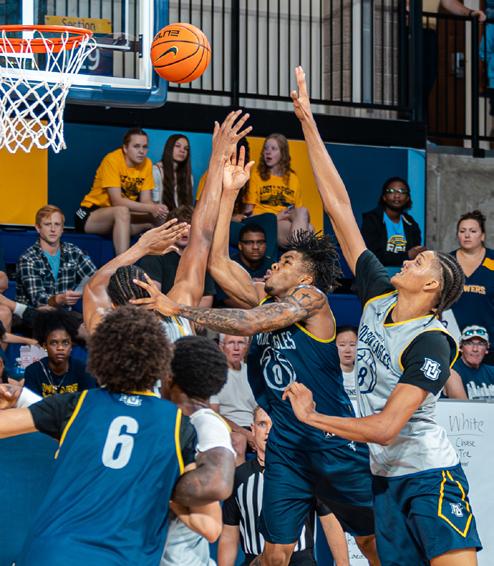

Basketball back on center stage
First-years lead Team Blue in MBB scrimmage
By Jack Albright jack.albright@marquette.edu
A fter more than a week of practice, and just under a month before the season-opener on Nov. 3 against Albany, we got our first look at what Marquette men’s basketball
See MBB page 6
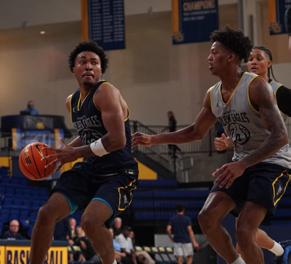
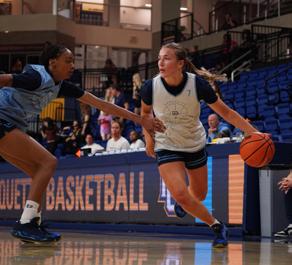
leo.stallings@marquette.edu
Golden Eagles' chemistry seen in WBB scrimmage
By Mikey Severson michael.severson@marquette.edu
M arquette women's basketball is the only Division I program to return every player from its 2024-25 roster this season.
And Friday night's
MEN'S GOLF
Golfers 'fortunate' amidst grind of Erin Hills

Tough conditions testing Marquette at Intercollegiate
By Trevor Hilson trevor.hilson@marquette.edu
TOWN OF ERIN — The large bronze clover overlooking the front nine at Erin Hills is as much a sign of history as it is a warning.
The silver letters reading ’80th U.S. Women’s Open Championship’ engraved on the bottom embody the course’s championship pedigree and toughness. On Sunday at the Marquette Intercollegiate, it gave players everything it had and more.
Despite knowledge of Erin Hills — Marquette’s played all but two of its signature events there, and the team has teed-off there
six other times this season — wind gusts of 35+ mph combined with a difficult course setup gave the Golden Eagle golfers struggles.
“The back nine played a lot tougher than the front nine today,” junior Ryan Banas said. “It was a grind. You just had to get the right breaks.”
Head coach Steve Bailey said that the familiarity of the course teaches them where to aim and, almost more importantly, where not to miss. But on Sunday, those past experiences could only help his team prepare so much.
“It’s definitely a different golf course today,” Bailey said, “one we haven’t seen.”
The course presents its unforgiving moments and challenges from scattered bunkers to drastic elevation changes — it’s maybe
easier to get a hole in one than find a flat lie — and thick fescue. Yet, with all those roadblocks, it is one of the more historic and beautiful monsters a golfer could experience.
During the practice round on Saturday, October 4, Bailey had Banas and the team take in the moment on the 10th tee, a 478-yard par four.
“Coach said that no matter your score, have a little perspective this week,” Banas said. “You can have a bad day, but it will never be too bad of a day when you are out at Erin Hills.”
Assistant coach Josh Robinson, who played in the 2019, 2021 and 2023 Marquette Intercollegiate at Erin Hills, said the access the team has to the course is program altering.
See ERIN page 8
MEN’S BASKETBALL
MBB: Pace a 'big advantage' this season
Continued from page 5
might look like this season.
There are still questions for the Golden Eagles, mainly surrounding how they’re going to replace graduates Kam Jones, Stevie Mitchell and David Joplin, but the new-look roster was on display Saturday in the annual Blue & Gold scrimmage at the Al McGuire Center.
“I thought it was a good, competitive setting,” Marquette head coach Shaka Smart said. “Any time you have half of your team going against the other half, there’s a fatigue level that sets in.
“That definitely occurred today. I told the guys afterward a lot of those plays were tired against tired. But those are good reps for us.”
Here are three takeaways from the scrimmage:
First-years Nigel James Jr. and Adrien Stevens show potential Team Blue was composed of veterans Zaide Lowery and Ben Gold, along with returning sophomore Caedin Hamilton.
But it was the first-years, Nigel James Jr. and Adrien Stevens, who pushed their team to a 70-52 win.
Stevens, who also stood out in the program’s open practice in July, continued to display his versatility by starting the scrimmage with a steal-and-score dunk before nailing threes from
each corner.
James Jr. was the person to really impress.
“He’s just got great energy,” Smart said. “He brings the juice, as we like to say.”
He was the first Golden Eagle to nail a 3-pointer, catching and draining one from the right corner without hesitation. He was also able to consistently get down low, his speed, athleticism and crafty finishing making up for his 6-foot frame.
And, if that wasn’t enough, he — who leads Marquette in deflections — also showed a gritty defense with active hands and strong mobility.
“He has a really high motor,” Lowery said of James. “His ability to make passes, his ability to score, play defense.”
Speed is the name of the game If Saturday showed one thing, even with uber quick point guard Sean Jones sitting out with a minor shoulder ailment, the Golden Eagles’ biggest advantage is their pace — something they’re going to have to press.
“Our pace is going to be a big advantage for us this year,” Lowery said. “I’m excited to see how it is for other teams and if they’ll be able to guard it.”
And maybe their biggest weakness is what happens when they don’t have that pace — something they’re going to have to work to fix
both before and once the season starts.
“We talk about our most important advantages a lot as a team, and one of them is playing with great speed and pace,” Smart said. “And [James Jr. and Jones], along with Chase Ross, have been the primary engines of that, and they’ve done a good job.
“There’ll be times where we may even play them together, but we want to get that ball up the floor as fast as we can. We’re going to get the ball in the paint as fast as we can.”
But what about when they get into half-court basketball and have to run actions?
“Most of the possessions are going to be in the half-court,” Smart said. “Although we want to be stubborn about seeing how many we can get in transition.
“We’ve got a lot of things we do in the half-court, too. We want to get to multiple actions. We want to get the ball in the hands of guys on the floor, after having the defense have to guard several different actions, where they can attack closeouts.”
Caedin Hamilton shows his aggression
Smart has talked before about the fact Marquette was over-reliant on Kam Jones to score last year, with Joplin being second-in-command. Now that both are gone, points are going to come
WOMEN'S BASKETBALL
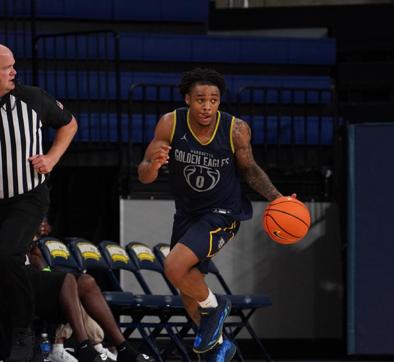
on the scoreboard in a different way.
On Saturday, there were signs of who could be the ones to step up. Hamilton was one of those people. The slimmed-down, muscled-up 6-foot-9 big man started the scrimmage with a won jump ball over 7-foot-1 Josh Clark before drawing a foul on the first-year center in the opening possession.
“His mindset’s come a long way,” fellow big man Gold said. “He steps on the court and his mindset is no one can mess with him on the court.
“You saw that’s how he tried to play today. He’s aggressive. He’s always the one setting the tone in the physical battle. That’s what we need from him. He’s
able to get those catches in the paint, and we can play through that and that’s going to be a big thing for us this year.”
Then he showed off his ball-handling, facilitating and hook-shot ability — inching closer to the 10,000 hooks Smart challenged him to make before the season-opener.
“Caedin’s been so bought in with his approach towards growth,” Smart said. “First and foremost as a person. “I think he realized coming in here that the belief in himself, the resiliency, the ability to handle hard things, that stuff had to be addressed and improved before we can talk about making jump hooks or getting rebounds.”
WBB: Forbes, Porter shine offensively
Continued from page 5
preseason Blue & Gold scrimmage at the Al McGuire Center provided a first look of the Golden Eagles in year two under Cara Consuegra.
Before the scrimmage began, the video board showed the program's terms and definitions for this season, like Consuegra's motto "HEART" and "Winning Plays."
The team played for 40 minutes of game time. Half came in a traditional intra-squad scrimmage format, while the team played against its practice squad for the other 20 minutes. Lee Volker, Olivia Porter, Skylar Forbes and Jaidynn Mason headlined Team Blue, while Bridget Utberg, Jordan Meulemans and Halle Vice highlighted Team White.
Here are some takeaways from the action at the Al: Marquette's offense in rhythm
The Golden Eagles returning everyone means the team-building and chemistry-sorting of last summer is no more. It's a completely different ballgame than it was 365 days ago — and you could tell from the jump. Mason scored the first points of the scrimmage with one of her signature speedy layups to the glass, the first of multiple throughout the night.
To end the first quarter, Porter — who was third on the team in number of 3-pointers made last year (20) — drained her first of the night.
Nearing the end of the second quarter, in another deja vu moment from last year, Forbes — a reigning All Big East First-Team selection— received a ball from Porter in the post.
Porter was patient with the pass, waiting for Forbes to signal for the pass as she backed down Vice.
Once she received the ball, Forbes pulled off a spin
move to face the basket and put the ball through the net.
The Blue and White portion was back-and-forth throughout the 20 minutes of play before finishing tied 21-21.
Bridget Utberg delivers from beyond the arc
A calling card for senior guard Utberg has been coming off the bench and giving Marquette a spark from beyond the arc.
Friday night, 3-point shooting continued to be a focal point of her game.
Utberg scored her team's first points of the scrimmage with a 3-pointer, a confidence that stayed present until the final buzzer.
In the second part against the practice squad, trailing close with the clock ticking down, Utberg stepped up to the top of the key and fired up the crowd by delivering a scrimmage-winning buzzer beater that sent the Marquette bench
into a frenzy.
Another 3-point threat with Utberg on team white was Meulemans. Meulemans, a sharpshooter who went 42.4% from deep in the 2023-24 season, transferred from Butler after missing last year with an ACL tear.
JJ Barnes' Injury
With over two minutes left in the first quarter, first-year guard JJ Barnes
went down near the basket as she looked to make a play towards the hoop.
She was down for a couple of minutes, clutching her knee and had to be assisted off the court by two staff members. Later in the scrimmage, she returned to the team bench with a brace on her left leg.
It's unclear what the injury was or how long Barnes may be sidelined.
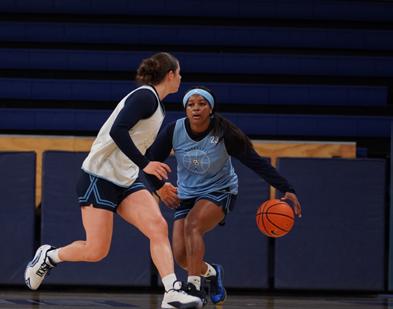
Students trying to form women's hockey team
Prospective club seeking approval from university
By Ben Ward benjamin.ward@marquette.edu
Erin Johnson comes from a huge hockey family.
Her dad played for the Michigan national team and used to coach triple-A. Because of the scarce number of girl’s hockey leagues around the country, she played on an all-boys team until she was 16 years old. Not being able to continue her love of hockey in college diminished her motivation for the sport but sparked her motivation to get the idea of a girl's club team off the ground.
So, when she saw that the program for club sports at the Marquette AMU only had a men’s hockey team, she took the opportunity to establish a new club on ice.
“I was crushed when I saw Marquette didn’t have a girl's hockey team," Johnson said.
From five members to 17 in a month, the amount of interest continues to grow for the club.
It all started on the satir-
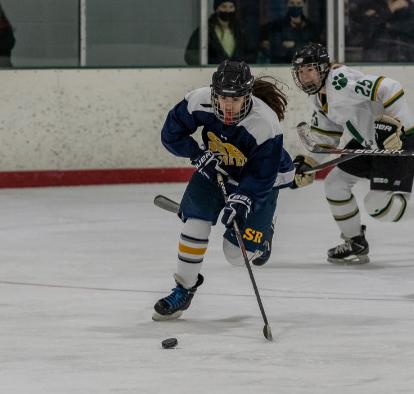
ical social media app, Yik Yak, when Johnson made a post about potentially starting a girls hockey club. The post garnered a couple of positive responses supporting the idea, so Johnson created a Snapchat form that got a wide variety of people interested.
One of those people is Lucy Hart, a sophomore in the College of Engineering.
“I had four people send it to me telling me I have to do this,” Hart said.
"I think it's more about providing the opportunity to allow girls to play."
Lucy Hart Women's hockey club member
MEN'S SOCCER
Hart played hockey throughout high school and enjoyed the experience so much she wanted to try and continue playing in college non-competitively. Hart’s team in high school provided a great environment and she wants a club team that can provide the same experience.
“As soon as I started, it was the structure of my life ... Coming here and not seeing there was a team forced me to stop playing," Hart said.
For Sidney Leonard, a junior in the College of Nursing, her passion for puck ran so deep that she emailed the Marquette Men's Division II head coach asking if there were any women’s teams in the area.
The reply? "No."
This year, Johnson plans on having an inaugural season of mostly practices encouraging more people to join and get them interested in the club.
Next year, however, the club wants to start playing games and joining tournaments to compete with some of the other schools in the area.
“We want to form a more competitive side to the
team,” said Hart. It’s hard for the team to determine who they’ll be playing against and at what level due to the wide variety of experience levels of currently interested members. Opponents from other schools will have to be within a 300-mile radius of Marquette.
Despite wanting to add a more competitive side to the team, the group of girls want to make the team more about getting people involved in the sport.
“I think it’s more about providing the opportunity to allow girls to play,” Hart said.
The group believes that the club will be a huge success because of the opportunities it provides to a community who’s been restricted.
“I think this club will give community to a lot of people whose community was shut off after high school,” Johnson said.
The group is planning to meet with the Director of Campus Recreation. James Friel, to present the written proposal for the team in hopes of becoming an official club sport. If approved, it’s onto the ice.
Pendleton is out of the boot and on the field
Foot injury kept junior midfielder sidelined last year
By Sofie Hanrahan sofia.hanrahan@marquette.edu
If you saw Nico Pendleton last Marquette men's soccer season, it was most likely in a boot on the sidelines.
It's not how he planned his sophomore season — especially after playing in 10 of 15 games his first year.
Only 20 minutes into a pre-season match against Green Bay last year, an errant kick to the foot ended Pendleton's season before it could even officially start. Before a concrete understanding of the injury, he actually attempted to play through it.
"That alone gives him some credit there for being tough and pushing through to try and do whatever it takes for the team to win," said assistant coach Calum Mallace.
Once the team returned to Milwaukee, X-rays confirmed the broken foot, and the end of the junior forward's season — but only on the field.
Injuries can bring out the worst in athletes, being

restricted from what they love most. But Nico attempted to do the opposite.
"I had to put aside the feeling sorry for myself," Pendleton said. "At first, when something like that happens, you're really disappointed, but once you put it into perspective, you put all that aside and focus on the team."
Without being able to contribute on the pitch, Pendleton found other ways to contribute to the team. He inhabited a new role that combined his experience as a player and
now an observer on the sideline to communicate ideas for improvement.
"Any time a player's injured, they kind of become an extension of the staff," men's soccer head coach David Korn said.
Pendleton rode this role out until he got cleared in November 2024. While not in time for the fall season, it gave him the opportunity to start training in the spring, with enough time to get back to full fitness for his junior season.
"Whether it's actual pain of what the injury was or
the pain of not being able to help contribute to the team it's a very difficult thing to do," Mallace said. "It's hard to stay positive, but Nico did a very good job of that."
Pendleton is back in uniform for the Golden Eagles sporting #10, despite being sick at the beginning of the season and having to sit out the first matches.
"I was a little nervous going into this season, I put a lot of pressure on myself," Pendleton said.
But having gone through adversity before, he knew
how to handle it.
"I haven't put any pressure on myself to perform well, more so just happy to be on the field," Pendleton said. "Having the opportunity to be out there and show other people what I'm capable of has been a good feeling."
What he may have been limited in demonstrating last season, he's showcasing now.
"He gives us the ability to connect and play through a number of positions covered a lot of the ground in the matches, making runs, trying to make it difficult on teams defensively at times," Korn said.
"His match performances have been ones that have been helpful to us earning results."
The junior forward has started five of the seven games played and leads the team in shots (22) and shots on goal (8).
Against Chicago State, he recorded a career-high three points courtesy of a goal and assist.
"I actually am a player," Pendleton said. "I'm not just sitting on the sidelines in a boot all the time."
So, when you see him back on the pitch this season, know it came with sacrifice and dedication.
CROSS COUNTRY
Emma Coon spearheading program rebuild
Junior has paced Marquette every meet this year
By Conor McPherson conor.mcpherson@marquette.edu
Under Jack Hackett, Marquette cross country has learned that progress is a marathon, not a sprint. For Emma Coon, growth blooms only after suffering, and the strength that follows.
"I'm kind of oblivious sometimes, like in my surroundings, which is kind of concerning because I live in a city, but it can help me during races, because I can turn my mind off and not really think the pain that I've been feeling," Coon said.
After a lackluster 2024, the women’s team has leaned on pace-setter Emma Coon to improve its standings.
It’s nothing new for Coon, a junior from De Pere, Wisconsin. A four-year letterwinner in cross country and track at De Pere High School, she qualified for the state championships every season. Since arriving at Marquette, she has led the women’s cross country team in each of
her three years wearing blue & gold. “She could be a national-class runner, and if she keeps improving the way she has, she’ll put herself in that position," head coach Jack Hackett said.
Coon broke out in 2024pacing the women's team in every race - and has continued her strong form into 2025, establishing herself as one of Marquette’s most reliable performers. Coon has finished 3rd, 7th and 24th overall through three meets this season.
On her last meet at Notre Dame on Oct. 3, Coon finished first among Marquette women and 24th overall in the 5-kilometer race, posting a time of 18:07.
Coon’s disciplined mindset has been vital to her results this season. At the Joe Piane Invitational at Notre Dame, Coon sat in 114th place after the first kilometer. Her splits steadily improved throughout the race, and a strong late push carried her to a 24th-place finish in the 5-kilometer event.
She opened the season at the Vic Godfrey Open with a third-place finish in 14:23 over 4K, helping Marquette to a second-place team
finish. She then competed at the Badger Classic, placing 10th in 22:46 over 6K and leading Marquette to another second-place team finish.
Marquette finished well behind the Wisconsin Badgers at the Badger Classic, but Coon competed with the best Madison had to offer.
"The goal has always been to focus on ourselves and on Emma, beating the version of herself from two weeks ago and continuing to get better," Hackett said.
Hackett continues to emphasize the squad’s mindset: keeping the focus on themselves rather than rival schools. Marquette is in the midst of a rebuilding stage under Hackett, and Coon has played a key role in that for the women's squad.
Hackett believes that Coon’s mindset is the driving force behind her success. He likens it to reaching Nirvana. Never mind the grunge rock band, but the Buddhist state of enlightenment from suffering — a fittingly high compliment from a coach to a runner.
“You chop wood, carry water, that’s something we’ve talked about," he
MEN'S GOLF

said. "It’s that kind of Buddhist philosophy, the way to enlightenment. That’s how Emma lives her life.”
In his first season in 2024, Marquette cross country struggled and was looking for a leader to help shape the program’s future. Coon is strictly focused on week-by-week growth and on helping the program improve.
“I think little wins will be increasing our spot in the Big East," Coon said. "Personally, I just want to hit
personal records and continue to enjoy running."
Coon and her stoic leadership are becoming a central focus for the team, and her success is quietly inspiring the squad.
“A rising tide lifts all boats. Hackett said. "By having somebody that’s better, it just pulls everyone else up too, because she’s there doing the work and you can see it. It’s contagious; when she does it, then somebody else does."
ERIN: MU ready for final day comeback
Continued from page 5
“We are very fortunate to be able to come to a place like this,” Robinson said. “We make sure our guys don’t take it for granted, but being able to go and practice and play before even stepping foot on property really helps us navigate what we need to do for when it comes to tournament time.”
Robinson said using knowledge to overcome what the course could present is a strong advantage. “Mentally preparing for
what’s to come and building more strategy with that and not deviating if it goes wrong is the biggest thing,” Robinson said. “Out here, you know you are going to have a bogey and that’s where the grittiness comes in.”
After the first day of play, Marquette tied-for-seventh with Rutgers University, the University of Alabama at Birmingham and Wisconsin at 25-over-par.
Sophomore Vincent Cervantes is the Golden Eagles’ leading individual after a four-over-par 76. His
AWARDS
Coco Dorfman
WSOC No. 6
First-year midfielder Coco Dorfman was named the Big East freshman of the week after amassing six points in Marquette's two wins. Dorfman assisted two goals in Wednesday's 3-1 win over St. John's. Three days later against DePaul, she scored two goals, including the game winner.
Clare Shea
three birdies, four bogeys and a triple-bogey were good for 10th place on the leaderboard.
On Monday, the wind
"We are very fortunate to be able to come to a place like this."
Josh Robinson Marquette golf assistant coach
died down and took high scores with it.
Marquette improved by 15 shots, led by an evenpar 72 from junior Mason Schmidtke. His five birdies, three bogeys and a double bogey helped him jump 21 spots to tied-for16th on the individual leaderboard.
Schmidtke said the team will have to make some noise amongst a jumbled leaderboard in the final round on Tuesday.
“We have a little bit more of an advantage tomorrow because we can definitely
chase on this golf course,” Schmidtke said. “We have to chase and beat as many teams as we can.”
The team is currently 16 shots back of the leaders, Clemson University, but Banas said the structure of team golf still means it’s anyone’s game.
“If you have five guys in the lineup and four of the five have a good day tomorrow, you can make a massive move, and we’ve seen that at a bunch of tournaments,” Banas said.

WSOC No. 22
First-year defender Clare Shea was named the Big East defensive player of the week. Shea led a back line that conceded only eight shots over two games, also scoring against St. John's. Your go-to
Opinions
MU needs more gender-neutral bathrooms

By Bella Gruber isabella.gruber@marquette.edu
While it may not be something that all students recognize, there are very few gender-neutral bathrooms on campus. With thousands of undergraduate students, Marquette needs to address this scarcity as an issue for the sake of students’ comfort and safety.
A study from the National Institute of Health and Medicine found that 70% of trans youth experienced trouble in accessing bathrooms, while 43% avoided toilets due to comfort or safety concerns. For cisgender people—those who identify with their gender assigned at birth—easily
finding a comfortable bathroom is a privilege that goes unrecognized. However, this does not provide an excuse to neglect the comfort of non-cisgender people.
Having access to a bathroom that you feel comfortable and safe using is a privilege that cisgender people do not often consider. However, in order to make Marquette’s campus an inclusive space for all students, equal access to bathrooms is an aspect of gender equality that must be considered. Currently, Marquette has gender-neutral bathrooms in some buildings, like on the second floor of the Lemonis Center for Student Success, in the Wellness +
Helfaer Recreation facility and in the lobbies of all university-owned housing structures. While this may seem like an adequate number of bathrooms for students, these are not generally known spots nor easily accessible.
For example, in all dorm buildings, you must receive a key to access the lobby bathrooms, and upperclassmen living off-campus are not likely to utilize lobby bathrooms in dorms. Conversely, the gender-neutral bathroom in the Wellness + Helfaer Recreation facility is not located in a centralized area; instead, it is on the third floor, tucked in a corner by the track. It does not help that these bathroom locations are not familiar to people. Due to a lack of knowledge and scarcity, students most likely have to hunt to find a gender-neutral restroom, which can become a burden.
The shortage of gender-neutral bathrooms is not only inconsiderate of non-gender-affirming students, but it speaks volumes about Marquette’s willingness to make all students
feel welcome and respected. Marquette must implement more of these bathrooms, making them accessible and convenient for students to use. Gender-neutral bathrooms should be in central places that don’t require students to walk out of their way simply to access a bathroom that they feel comfortable in.
They should also be welcoming and clean – Lemonis Center for Student Success does a great job of this, for its gender-neutral bathrooms are spacious, clean and contain free feminine products.
Many buildings on campus are old, but Marquette has made renovations to them as updates have been needed to adapt to the university’s needs. The university must consider LGBTQ+ students when making changes to buildings, as these updates impact all students on campus for years to come.
Marquette offers support for the LGBTQ+ community through campus resources and clubs. The LGBTQ+ Resource Center, located in the Alumni Memorial
Union, provides a safe space for LGBTQ+ students by advocating for their needs and giving students the resources they need. They are open to diverse conversations with all individuals to recognize queer identities on campus.
Gender Sexuality Alliance is a student-led organization at Marquette that also aims to give queer students a voice. They build community through hosting regular meetings and bonding activities. Adding more inclusive bathrooms to campus would advocate for Marquette’s LGBTQ+ community and would allow allies to encourage this sense of belonging for all students. Marquette prides itself on “cura personalis,” or “care for the whole person,” but not allowing all students to feel comfortable in their own skin contradicts this value. Marquette must focus on the needs of all students by installing gender-neutral bathrooms in accessible spaces across campus.
Bella Gruber is an opinions columnist. She is a sophomore studying public relations.
Government shutdown signals concerns
By Rachel Lopera rachel.lopera@marquette.edu
The U.S. has a president who claims to be a great dealmaker, yet our government has shut down because it couldn’t make one. Donald Trump and Republicans cannot run a country if they are not capable of compromise.
The U.S. federal government shut down on Oct. 1 because lawmakers failed to resolve a budget dispute, because they couldn’t agree to pass a bill funding government services into October and beyond.
The president and the legislature must agree before spending plans can become law.
Currently, Republicans control both chambers of Congress. In the Senate, they were short of the 60 votes needed to pass the spending bill, and Democrats did not budge.
The Democrats proposed a bill that would have reversed Trump’s cuts to Medicaid and extended health care subsidies, making health insurance cheaper.
The lack of agreement prompted the government shutdown.
However, healthcare should be a top priority for our lawmakers as it affects millions of people. The Affordable Care Act subsidies
will expire at the end of the year, and Democrats wanted to extend them.
“The longer Congress waits to extend them, the more damage and chaos there will be in the meantime,” Larry Levitt, a health care policy expert at Kaiser Family Foundation, a nonpartisan research group, said.
Democrats do not want more spending cuts to government health agencies because it limits access to resources. The elderly, disabled and low-income populations use these government healthcare programs because they are accessible, and sometimes, it is their only option.
The ignorance of the GOP has led to the third government shutdown under Trump’s presidency. Two shutdowns occurred during his first term, one of them lasting 35 days, the longest in history.
It seems like a pattern has taken place where a lack of negotiation from Trump and the Republicans ends in a complete government halt – something that is extremely concerning for America.
“We want to sit down and negotiate,” Senate Minority Leader Chuck Schumer said at a news conference after the Senate voted Sept. 30.

“But the Republicans can’t do it in their partisan way, where they just say it’s our way or the highway.”
If our leadership cannot handle civil dialogue about issues that have enormous impacts on its citizens, then we should not have to listen to their unreasonable demands.
Now, many people will suffer the effects. Federal workers deemed non-essential will be put on temporary unpaid leave, and those still employed will not be paid until the government reopens. Potentially four million federal employees will not receive a paycheck.
Military personnel will also continue their roles without compensation until a funding deal is reached.
The Department of Health and Human Services, home to agencies like the Centers for Disease Control
and Prevention, is expected to furlough many workers, impacting ongoing research projects.
The president and Congress must come to an agreement on passing new spending legislation for the government to reopen, so it is hard to say how long the shutdown will last.
The U.S. is stepping farther and farther away each day from the democracy it is supposed to demonstrate. This shutdown is more than just our higher-up politicians disagreeing. It emphasizes the dysfunctionality of our leadership and questions the authority of our president.
The absence of civic discourse in our government is detrimental to America’s future and should no longer be tolerated.
Statement of Opinion Policy
The opinions expressed on the Opinions page reflect the opinions of the Opinions staff. The editorials do not represent the opinions of Marquette University nor its administrators, but those of the editorial board.
The Marquette Tribune prints guest submissions at its discretion. The Tribune strives to give all sides of an issue an equal voice over the course of a reasonable time period. An author’s contribution will not be published more than once in a fourweek period. Submissions with obvious relevance to the Marquette community will be given priority consideration.
Full Opinions submissions should be limited to 600 words. Letters to the editor should be between 150 to 300 words. The Tribune reserves the right to edit submissions for length and content.
Please e-mail submissions to: rachel.lopera@marquette. edu. If you are a current student, include the college in which you are enrolled and your year in school. If not, please note any affliations to Marquette or your current city of residence.
Fun & Games
Ice cream Flavors
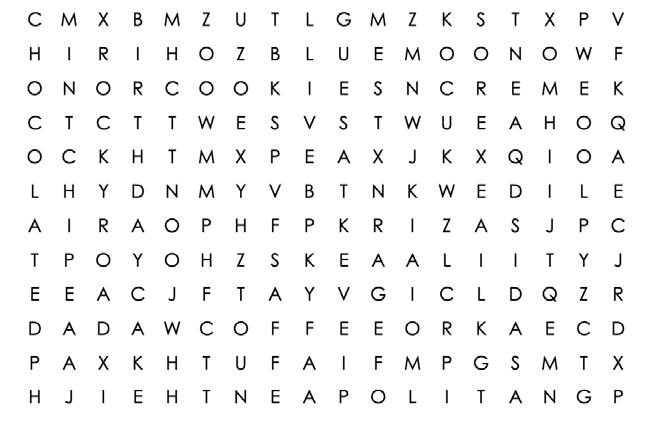
COOKIESNCREME NEOPOLITAN BLUEMOON COFFEE MOOSETRACKS CHOCOLATE VANILLA MINTCHIP STRAWBERRY ROCKYROAD CHERRY SUPERMAN
Delightful Desserts

Arts & Entertainment
REVIEW: Skylight's 'Fiddler on the Roof'
By Elise Emery elise.emery@marquette.edu
The musical is the first show in MU Theatre's season
“Fiddler on the Roof” premiered on Friday night in the Cabot Theatre, marking the first show of
Skylight Music Theatre is a professional performing arts center located in the Historic Third Ward District in Milwaukee, Wisconsin. The theatre produces a wide repertoire of works, ranging from opera to musical theater. The company produces over 100 shows each season and also has an arts-in-education program that offers
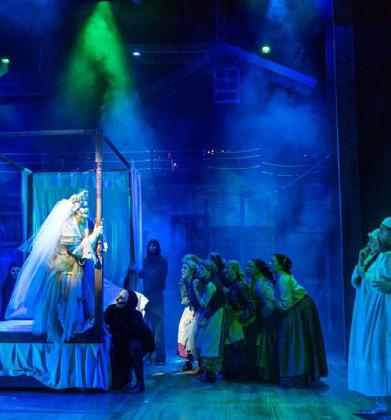
Marquette Theatre’s 20252026 season titled “Viewpoints.” Unlike their previous and upcoming theatre productions—which are
free performing arts workshops and performances for students in Milwaukee Public Schools. For the production of “Fiddler on the Roof,” the
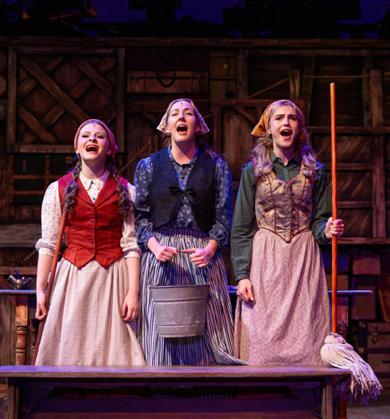
in the Helfaer Theatre— Marquette Theatre’s production of “Fiddler on the Roof” worked in collaboration with Skylight Music Theatre. The show on Friday had a full house and celebrated a sold-out show for their first night of their residency in the Skylight Music Theatre.
cast had a mix of professional actors and Marquette students playing the roles. Characters like Tevye and Golde were played by professional actors, but many Marquette students had leading roles, and some were scattered throughout the ensemble. The structure of the
Cabot Theatre upon arrival was absolutely stunning. The theatre, while compact, didn’t feel cramped; instead, it was like the audience was immersed in the show. I sat on the orchestra’s left, mere inches away from the action, making me feel like I was transported to Anatevka, Ukraine, along with the cast.
Upon the curtain opening, the first thing I noticed was the pit orchestra’s placement on the stage. Having been involved in the pit orchestra for musical productions in high school, I had only ever seen the musicians offstage.
This choice, especially for this show, was particularly smart. It emphasized the musicians, allowing the audience to appreciate them simultaneously with the cast. It added moments for the musicians to be a part of the story, most notably with the consistent character of the Fiddler, who opens the show and occasionally appears in scenes.
Since its Broadway debut in 1964, “Fiddler on the Roof” has established itself as a classic, winning several Tony Awards and consistently returning to the stage in the United States and abroad. The story follows Tevye, a poor milkman living in Czarist Russia, as he navigates upholding traditional Jewish values while raising his five daughters in a changing world.
The show sets the tone by starting with “Tradition,” sung by the entire company. The song encapsulates Anatevka’s culture, priding itself on upholding and continuing tradition. This is the foundation of the community, but it also creates greater conflict.
Tevye—played by Andrew Varela—remained a consistent standout throughout the show, and unsurprisingly so. Varela brought both humor and humanity to the character, with every one of his scenes being a delightful balance of laughter and emotion. He sang each song with such heart, consistently demonstrating the character’s inner conflict between maintaining tradition and caring for his family.
A standout song from Act 1 was “Matchmaker, Matchmaker.”
Sung by three of the five daughters of Tevye, Tzeitel—played by Erin Fricker—Hodel—played by
Kynkade McLachlan—and Chava—played by Naomi Kriege— all three seniors in the College of Communication, the song illustrates the imaginative fairytale future the younger daughters believe will come when the matchmaker provides a match.
Until Tzeitel, the oldest daughter, informs them that matchmaking isn’t all it’s cracked up to be.
The blend of the three actresses’ voices was seamless and lively throughout the performance, but each singer also brought talent and a polished tone to each note. McLachlan, in particular, was outstanding in her placement and execution of her singing, showcasing a range of emotions throughout her performance in the show.
Tzeitel. Motel was a character I was consistently rooting for, as his sweet, awkward demeanor made him nothing but lovable.
My personal favorite song was “Tevye’s Dream,” as not only did the song incorporate humor with incredible acting and singing, but the staging for the song was the most complex and visually interesting in the show.
Despite the only prop on stage being a bed, the incorporation of lighting, projectors and silly gimmicks made the song dynamic. In the scene, you never knew what to expect next, making it the best part.
The ending left the audience with much to consider. Performances that close with an unanswered
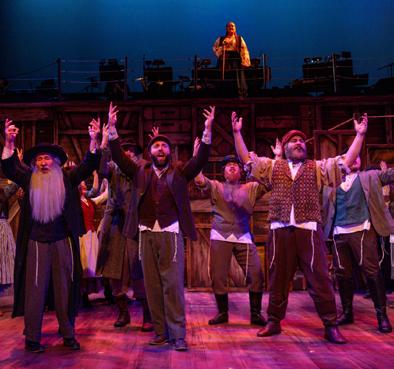
Motel—played by Grayson Buesing, a junior in the College of Communication—was perfectly awk-
question give the audience something to carry with them—a piece of the story that begs for reflec-

ward. His performance in “Miracle of Miracles” truly demonstrated the diversity and shift in his character.
He exuberated a childlike sort of excitement by jumping on tables and dancing recklessly after finding out he could marry
tion—and to me, those are the most valuable stories of all.
“Fiddler on the Roof” will continue its run through Oct. 26, with tickets available for sale on the Skylight Music Theater website.
A new favorite MKE Mexican delivery spot
By Joey Schamber joseph.schamber@marquette.edu
There’s nothing wrong with defaulting to Taco Bell or Qdoba when searching for a quick bite to eat on meal delivery apps, but I am here to tell you what you probably already know: there are so many better
Uber Eats.
Mi Tierra’s food can be best described as comforting. They may not be pushing the boundaries of cuisine out of their Walker Square restaurant, but there is next to nothing on their expansive menu that won’t satisfy your cravings.

options out there for Mexican food.
Understandably, it can be daunting to stray away from the fast-food staples you have grown comfortable with, but if you are ready to take the leap, try Taqueria Mi Tierra.
The restaurant, located at 1401 W Washington St, has a charmingly eclectic atmosphere. It is clean, well maintained and the service is attentive. While it’s worth it to venture down to this spot, I know a lot of students may not want to make the trip.
Luckily, Mi Tierra is a sleeper hit on apps like DoorDash, Grubhub and
Their tacos ($9.75) come on your choice of regular corn, homemade corn (+$3.75) or homemade flour tortillas (+$3.75). If you ask me, it’s well worth the extra few bucks to upgrade to the homemade ones. The soft circles are so rich with fresh masa flavor that I could eat them on their own. They make for the perfect vehicle for any of their delicious meat choices.
Al pastor tends to be my favorite option, and Mi Tierra’s certainly delivered. I also enjoy the carne asada, chorizo and carnitas. The braised options, in-
cluding the barbacoa, cabeza and lengua, needed a bit more salt, which is unfortunate because they otherwise had a wonderful flavor and texture.
Mi Tierra also makes a great burrito ($8.95). They don’t stuff it full of fillers like rice; instead, they keep it simple: lettuce, tomatoes, beans, cheese, sour cream and your choice of protein.
The proportions of ingredients were exactly how I like them, and I appreciated that the burrito didn’t threaten to fall apart while I was eating it.
My favorite item on the menu was the pambazo ($8.75). A pambazo is a sandwich served on plush telera bread that has been soaked in a guajillo chile sauce and fried on a griddle. It is stuffed with chorizo, potatoes, creamy refried beans, sour cream, lettuce and queso fresco.
The result is a soggy, messy sandwich that might sound unappetizing to the unacquainted, but one bite will prove you dead wrong. This sandwich is comfort on a bun, and despite the heavy toppings, it is surprisingly light from the bright tang of the queso fresco and sour cream.
Be warned, while Taqueria Mi Tierra does a fantastic job wrapping up your meal for delivery, this sandwich will be a challenge to pick up if you order it online. I recommend taking

a trip to dine in if you want this sandwich.
Whether you are eating inside their quaint dining room or ordering off your delivery app of choice,
Taqueria Mi Tierra should be on your radar. The restaurant is open from 7 a.m. to 10 p.m., though delivery hours may vary between apps.

REVIEW: MU's 'The Tragedie of Ophelia'
A six-person play with minimal lighting and set
By MaryKate Stepchuk marykate.stepchuk@marquette.edu
Tucked in the Debra Krajec Studio of Helfear Theatre, Marquette Theatre presented “The Tragedie of Ophelia: Lady of Denmark” on Oct. 5 and 6. The 50-minute play directed by Jamie Cheatham—professor and head of acting at Marquette—provided an on-campus production for those not in “Fiddler on the Roof”— which is in partnership with Skylight Music Theatre and running until Oct. 26.
Serving as a portion of “Hamlet,” the play highlights Ophelia and her tragedy, rather than treating her as a background love interest. It offers deeper insight into her story, which is often neglected and overlooked by “Hamlet” enthusiasts.
The smaller production consisted of a six-person cast, simple costumes, a minimal set and a few basic lighting changes, allowing the actors and actresses to emphasize their acting over anything else.
Tickets were free to the public, and the show was packed, forcing some audience members to stand during the performance. I arrived 15 minutes early, and I snagged one of the last seats.
Ophelia—played by Erin Cavender, a senior in the College of Communication—and her brother, Laertes—played by Elisabeth Draper, a first-year in the School of Education— replicated a sibling banter on stage that many can relate to, drawing laughs from the audience.
Blue lighting then overcame the room as the ghost of Hamlet’s father—played by John “JR” Francis, a first-year in the College of Communication—appeared, making audience
members’ heads turn to the back of the room.
Only a crown and cloth covered the ghost’s face, but the simple and effective use of costuming left not only Hamlet—played by Christian Wood, a firstyear in the College of Communication—but also the audience members with an eerie feeling of what was to come for Claudius’ fate.
Throughout the show, red lighting would appear when Hamlet went on rampages, demonstrating his anger. Wood’s acting only added to this aspect, as his rage could be seen in his eyes and the veins slightly popping out of his neck with a red flush on his face.
While the show established Hamlet’s character and mental state, I found myself thinking that there was too much time spent establishing Hamlet, considering this was supposed to be about Ophelia’s story. But as the show went on, the focus shifted back to Ophelia.
Polonius—played by Dylan Guiliano, a sophomore in the School of Education—did a fantastic job as Ophelia’s controlling father. Guiliano’s precise mannerisms displayed dominance over Ophelia, especially when he began speaking for her during interactions with Claudius— also played by Francis.
During these interactions, Cavender’s body language spoke volumes about how powerless she felt within her family dynamics.
Ophelia holds true love for Hamlet, but between Laertes and Polonius' dominant characters with Hamlet’s erratic behavior, she often finds herself conflicted and torn between staying true to her heart or family lineage.
In these moments when the people around Ophelia discuss her without her input, Cavender is often slightly hunched forward with her arms crossed in front of her body, showing
how shy and uncomfortable she feels.
This use of physical acting adds another complexity to her performance that is difficult to achieve, but she perfects it.
Even with her impressive physical acting, Cavender’s performance peaked at the show’s end after she drowned.
She becomes a ghost— replicating a glassy, pale look on her face—carrying red flowers as people mourn at her grave. The lack of emotions on her face shows how numb she became after Hamlet killed her father, and how it continued, even to the moment of her death.
For a short play, all six cast members utilized the minimal set to highlight their acting abilities. They created a compelling story with an untraditional take on “Hamlet,” leaving audience members reconsidering how Ophelia was originally depicted.
